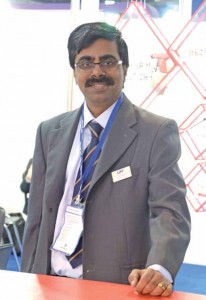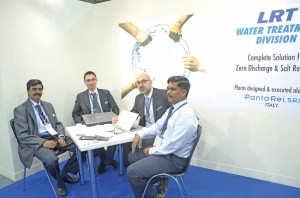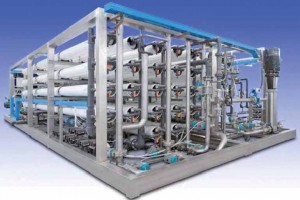Textile industries consume comparatively more water, after thermal, engineering and pulp & paper industries. In India water consumed by textile industries in 2010 was around 1900 Mm3 (million cubic metres) and effluent water generated was around 75 per cent of its intake.
Availability of fresh water is getting precious by every passing day due to irregular rainfall, air pollution, poor water management, poor or no ground water level replenishment, industrial effluent and sewerages run-off into river, lake, etc.
Fresh water availability is declining much faster than expected, and it is time for the industries to reclaim their water from its effluent to overcome the water shortage. Water reuse makes them free from fresh water demand and saves the earth for future generation.
LRT India, the largest manufacturer of ring travellers in the world, serving over 4,500 spinning mills over 35 countries, brings you the most successful and proven treatment methods for textile dyeing effluent along with its overseas partner Panta Rei s.r.l, Italy.
The complete solutions as detailed below were on display at India ITME 2012 in Mumbai.
Biological method
 Biological oxidation process is widely used and recommended due to its positive results, lower sludge generation and low running costs. The main objective of biological treatment is the oxidation of the dissolved and particulate biodegradable constituents so that the polluting organic and inorganic compounds are removed or significantly reduced.
Biological oxidation process is widely used and recommended due to its positive results, lower sludge generation and low running costs. The main objective of biological treatment is the oxidation of the dissolved and particulate biodegradable constituents so that the polluting organic and inorganic compounds are removed or significantly reduced.
Dye effluent has higher pH and that need to be neutralized for bacterial activity. The removal of excess acidity or alkalinity by a chemical agent is called neutralization. Industrial waters that were exposed to extremely high or low pH values require a neutralization process before they can be sent to a biological treatment or the environment. The reason is that the biological treatment required neutral pH conditions; otherwise the bacteria that perform water purification are severely affected.
Acidic wastewaters can be neutralized with basic chemicals (the most common being sodium hydroxide, also known as caustic soda, lime and sodium carbonate). The basic wastewater can be treated with acid chemicals; the most used being sulfuric acid at 98 per cent.
The water is sent to the biological oxidation tank through feeding pumps that guarantee a homogenous flow. Biological oxidation is the most important phase of the treatment, in order to achieve degradation of the pollutants that are present in the water flow, which takes place in the following order:
1. Bacterial cells assimilation
2. Total biodegradation or mineralization
3. Partial biodegradation
4. Co-metabolisms
5. Bio-absorption by solid matrixes
Biological oxidation
The oxygen transfer from the gaseous phase to the liquid phase (water) is a crucial part of the wastewater treatment, especially when it is performed by the activated sludge. Since the solubility of oxygen in water is low, and thus the natural oxygen transfer is low, the oxygen that is necessary for the biological process oxidation does not enter the water naturally, also because the air-water interface is very limited.
Thus additional interfaces need to be created in order to carry out the process. Oxygen can be supplied as pure bubbles or as air. Air bubbles are generally chosen instead of pure oxygen bubbles since the cost is much lower. The air is provided through blowers; once the air supply has been sent through the air piping, it arrives to the air diffusers.
Sedimentation
Sedimentation is the term applied to separation of suspended particles that are heavier than water by gravitational settling. In the case of the proposed biological wastewater treatment, it is used for removal of the activated sludge flocs, and it is carried out in a settling basin, called secondary clarifier.
The main factors affecting the sedimentation process are the treated flow, the area and the particle setting velocity. The area (and thus the diameter) is obtained using the flow and the recommended settling velocity, which for the biological treatment processes is about 0.33 m/s. A scraping bridge is installed in the secondary clarifier tank, which has a girder bridge that acts also as a flying bridge or catwalk. The top scraper removes the floating material and foam, while the bottom scraper sends the settled sludge to the center where it is pumped back to the process.
Most of the removed sludge is sent back to the process, in order to keep a constant concentration of activated sludge in the biological oxidation or aeration tank, so that the process efficiency is also constant. The activated sludge return is a key part of the process, and this is done through the activated sludge return pumps. The excess sludge that is produced is sent to the thickening tank.
Reverse osmosis plant
 The reverse osmosis treatment generally is applied to desalting of seawater and brackish water destined for human consumption, low pressure boiler feeding, feeding of ion exchange demineralization plants and other processing use. The aim of the treatment by inverse osmosis is reduction of 95-98 per cent of dissolved salts and removal of bacterial charge from clear (filtered) water.
The reverse osmosis treatment generally is applied to desalting of seawater and brackish water destined for human consumption, low pressure boiler feeding, feeding of ion exchange demineralization plants and other processing use. The aim of the treatment by inverse osmosis is reduction of 95-98 per cent of dissolved salts and removal of bacterial charge from clear (filtered) water.
The process of reverse osmosis is based on the peculiarity of half-permeable membranes, which water (or other solvents) is passing through, while molecules are retained as well as the ions of the dissolved solids. In normal conditions, when such a membrane is inserted between an aqueous solution and water, due to the pressure difference caused by difference on density the solvent is passing through the membrane to the solution (direct osmosis).
Separation of the solvent from the solute can be obtained by means of large pressure difference due to the application on the more concentrated solution of a higher pressure than the pressure of the other side of the membrane (reverse osmosis). The velocity of solvent passage results to be much higher as higher is the pressure difference. Also many dissolved solids are diffused through the membranes in the lower concentration side.
The process of reverse osmosis allows water purification and dissolved solids concentration operations without any change in status and with a low consumption of energy. The separation process is obtained by means of a high pressure pumping of the dissolved solids solution to be treated; from membrane-type devices called modules, two different flows under the influence of the pressure are obtained. The first flow (the orthogonal one) is passing through the membrane, and at the outlet high reduction of salts and organic take place, while the second flow (the tangential one) is passing over the surface layer before the membrane. Two final results are obtained from the feeding flow through the system: the so-called product (more diluted) and the concentrate.
The performance of a reverse osmosis plant is related as first to the average capacity of product (the permeated flow) and to the concentrate (the rejected flow) of the membranes. Permeated flow and rejected flow are mostly due to the peculiarity of the used membranes (permeability to liquids, impermeability to solids), but at the same time they are also affected by the chemical and physical conditions of the process, such as pressure, temperature, pH, concentration and composition of the feeding solution.
In other words the permeated flow: increases (or decreases) according to the temperature, and it is connected to the viscosity. The variation index changes according to different types of modules, and it is usually supplied in a table. If the temperature of the feeding solution changes frequently, it is often necessary to adjust the running conditions. This is a disadvantage for the manually adjusted plants.
Increases if the running pressure increases: It not always convenient or possible to work at high temperatures; still, the pressure-resistance limits of the modules must always be taken into consideration.
Decreases if the concentration of the feeding solution increases: However, unlike the temperature, the relation between the two cannot be generalized. Decreases over the time, due to progressive irreversible degradation of the membranes; when the permeated flow increases and its quality decreases, it means that the active layer of the membrane has been worn or oxidized.
The quality of the permeated flow depends mainly on the rejection of the membranes: the rejection is sized through the ratio between the difference in concentration between the feeding solution and permeated flow and the feeding solution concentration. The rejection factor is dimensioned usually with reference to a single component like sodium chloride.
The rejection flow increases when the pressure increases, as this affects the difference between the velocity of water and the velocity of solids through the membranes. Decreases over the time, due to the progressive surface fouling of the membranes.
The quality of the permeated flow does not depend only on the rejection: even if the rejection is constant, the concentration of the permeated flow could increase or decrease according to the concentration variations of the feeding solution. As inside the modules (especially if placed in series) the concentration increases gradually from the inlet to the outlet, the permeated flow will get progressively worse. It is therefore clear that the actual performances of the plant in terms of productivity and quality (concentration) of the parameters depend also on the recovery factor (or conversion factor). Such a factor describes the quantity ratio between permeated flow and feeding solution concentration.
Whatever deviation of the recovery factor from the fixed value, due to either a specific decision of the operator or external reasons, will always produce variations in the quality of the permeated flow. Although the flow is steady, an eventual worsening of the quality of the permeated flow (which is immediately recognized by an increase in the conductivity), can be due to variations in the concentration of the feeding solution concentration or in the recovery factor. These two causes are easy to detect and correct, but if worsening in quality depends on problems of fouling or chemical damage of the membranes, nothing can be done to solve the problem.
Automation
 Biological treatment is the simplest method of treatment for textile effluent, but we need to maintain the following parameters for best results and longer working life – dissolved oxygen in aeration tank, pH, TSS, temperature, pressure and tank levels, etc. Physical monitoring of the above parameters is critical, and any damage to the membrane and process equipment is irreversible.
Biological treatment is the simplest method of treatment for textile effluent, but we need to maintain the following parameters for best results and longer working life – dissolved oxygen in aeration tank, pH, TSS, temperature, pressure and tank levels, etc. Physical monitoring of the above parameters is critical, and any damage to the membrane and process equipment is irreversible.
LRT – Panta Rei S.r.l brings you fully automated biological plants to overcome the human error, and the programmed logic control (PLC) will benefit you with minimum manpower, lower operating cost, longer working life of equipments and best effluent treatment. Plants are designed for wider parameters and the possibility of changing the operating mode of the installation according to the different parameters of injection.